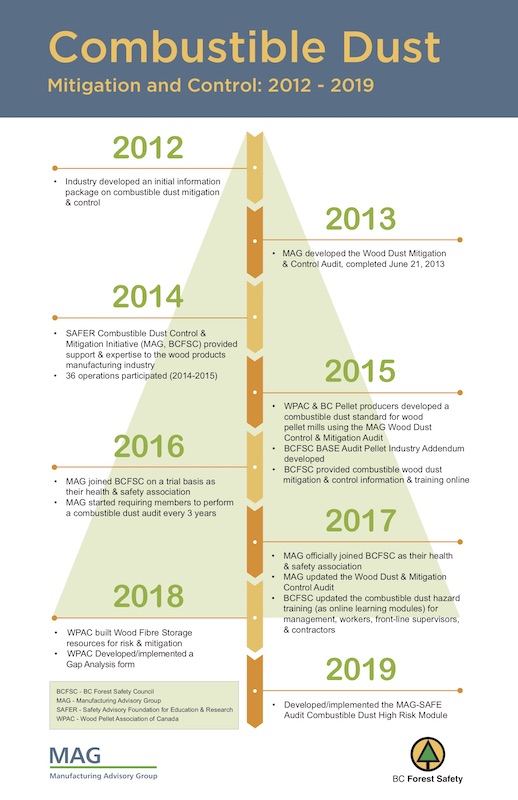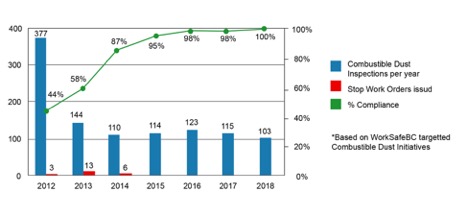
Features
Health and Safety
Sawmilling
Progressing combustible dust mitigation and control
Sawmills move from 47% compliance to 100% compliance
June 24, 2019 By BC Forest Safety Council

More than seven years ago two tragic sawmill explosions took the lives of four men. The incident shook the industry and inspired immediate action.
The significant risks associated with wood dust in manufacturing propelled the forest products manufacturing industry, labour unions and WorkSafeBC to come together and work on strong mitigation and control measures from 2012 to 2018.
During this time, the number of B.C. sawmills that underwent inspections and responded to WorkSafeBC recommendations rose from a 47 per cent compliance rate to 100 per cent compliance and industry-wide support for combustible dust inspection initiatives.

In 2019, there are well-established, significant mitigation and control practices in place to eliminate wood dust risk. Such practices involve monitoring operations for potential hazards, employee training, an annual review of combustible dust programs, and an external audit every three years.
For instance, all engineered ventilation systems are monitored and maintained on a regular basis to reduce wood dust accumulation. Manufacturing sector employees are trained on combustible dust hazards, safe cleanup methods, their right to refuse unsafe work, and reporting procedures for any observation of excessive wood dust accumulation to ensure immediate and appropriate actions.
Industry programs began with an initial information package on combustible dust mitigation and control in 2012. The following year, the Manufacturing Advisory Group (MAG) developed and implemented the Wood Dust Mitigation and Control Audit. Over 2014 and 2015, a Combustible Dust Control & Mitigation Initiative saw 36 mill operations receive support and expertise about the hazards and recommended controls.
The Safety Advisory Foundation for Education & Research (SAFER) also supported combustible dust awareness and training. In May 2014, United Steelworker (USW) members located in four regions in B.C. were provided education, hands-on training and tools to perform wood dust inspections to support the Joint Occupational Health and Safety Committees and act as SAFER Combustible Dust Advisors.
In February 2015, the Wood Pellet Association of Canada (WPAC) and B.C. pellet producers developed a combustible dust standard for wood pellet mills using the MAG Wood Dust Control and Mitigation Audit and BCFSC BASE Audit Pellet Industry Addendum. In the same year, key information and targeted training modules went live on the BC Forest Safety Council website.
In addition, WorkSafeBC sponsored combustible dust education and training resources were made available online and as information sessions.
More recently, in 2018, WPAC developed wood fibre storage resources for online access, including risk and mitigation and a gap analysis form. And in 2019, the MAG SAFE Audit was implemented to include a combustible dust high risk module.
Overall, industry invested more than $100 million over three years (from 2013 to 2016) in mitigation and control measures for combustible dust hazards. Industry knows there can be no complacency in safety and remains focused on maintaining its excellent compliance rates and seeking continuous improvements in overall safety performance.
For a timeline of combustible dust mitigation and control, click here.
This article originally appeared in BC Forest Safety Council’s Forest Safety News June 2019 edition.
Print this page